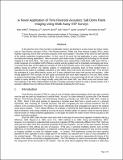| dc.contributor.author | Willis, Mark E. | |
| dc.contributor.author | Lu, Rongrong | |
| dc.contributor.author | Burns, Daniel R. | |
| dc.contributor.author | Toksoz, M. Nafi | |
| dc.contributor.author | Campman, Xander | |
| dc.contributor.author | Hoop, Martijn de | |
| dc.contributor.other | Massachusetts Institute of Technology. Earth Resources Laboratory | en_US |
| dc.date.accessioned | 2011-12-22T19:29:40Z | |
| dc.date.available | 2011-12-22T19:29:40Z | |
| dc.date.issued | 2005 | |
| dc.identifier.uri | http://hdl.handle.net/1721.1/67883 | |
| dc.description.abstract | In the past few years, there has been considerable research and interest in a topic known by various names, such as Time Reverse Acoustics (TRA), Time Reverse Mirrors (TRM), and Time Reverse Cavities (TRC), which exploits reciprocity and the time symmetric property of the wave equation. Very little of this work has been directed at the seismic exploration imaging problem. In fact, most of the work has had application in sonar, medical and non-destructive testing applications. Here we present some initial results of applying this technology to the seismic imaging of a salt dome flank. We create a set of synthetic traces representing a multi-level, walk away VSP for a model composed of a simplified Gulf of Mexico vertical velocity gradient and an embedded overhanging salt dome. To process these data, we first apply the concepts of TRA to the synthetic traces. This creates a set of stacked traces without having to perform any velocity analysis or complicated processing. Each of these stacked traces is equivalent to the output of a spatially coincident, or zero offset, down hole source and receiver pair. Thus we have the equivalent of a zero offset seismic section as if it were collected from down hole sources and receivers. After having applied the TRA concepts, we then apply conventional post stack depth migration to this zero offset section to produce the final image of the salt dome flank. Our results show a very good image of the salt. In fact, the image created is nearly identical to an image actually using data from down hole, zero offset source and receiver pairs. The simplicity of the TRA implementation provides a virtually automated method to create a stacked section as if it had been collected from the reference frame of the borehole containing the VSP survey. | en_US |
| dc.description.sponsorship | Massachusetts Institute of Technology. Earth Resources Laboratory | en_US |
| dc.publisher | Massachusetts Institute of Technology. Earth Resources Laboratory | en_US |
| dc.relation.ispartofseries | Earth Resources Laboratory Industry Consortia Annual Report;2005-03 | |
| dc.title | A Novel Application of Time Reversed Acoustics: Salt Dome Flank Imaging Using Walk Away VSP Surveys | en_US |
| dc.type | Technical Report | en_US |
| dc.contributor.mitauthor | Willis, Mark E. | |
| dc.contributor.mitauthor | Lu, Rongrong | |
| dc.contributor.mitauthor | Burns, Daniel R. | |
| dc.contributor.mitauthor | Toksoz, M. Nafi | |
| dc.contributor.mitauthor | Campman, Xander | |
| dspace.orderedauthors | Willis, Mark E.; Lu, Rongrong; Burns, Daniel R.; Toksoz, M. Nafi; Campman, Xander; Hoop, Martijn de | en_US |

